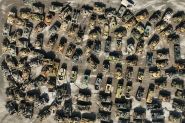- Home
- Middle East
- Syria: From Pariah State to a Guest in Washington

©Page Telegram de la présidence syrienne / AFP
This Monday, Donald Trump is hosting Ahmad al-Sharaa at the White House. It is a historic moment: never before has a Syrian president been officially received in Washington since the country gained independence in 1946.
The event symbolizes the end of half a century of hostility between the two capitals. For a long time, Syria was one of the most isolated countries in the world, viewed by the United States as a hub of terrorism and a conduit for Iranian and Russian influence in the Middle East.
The Assad Era: State-Sanctioned Anti-Americanism
Under Hafez al-Assad, Syria emerged in the 1970s as a key stronghold of the Soviet bloc and the so-called “resistance axis” against Israel and the United States. At the time, Washington viewed Damascus as an anti-Western power, hostile to any compromise.
Syria’s consistent support for Palestinian armed groups, Hezbollah, and Hamas led to its designation in 1979 as a state sponsor of terrorism by the United States.
From that point on, any high-level bilateral engagement was out of the question: inviting a Syrian president to the White House would have been regarded as a breach of U.S. legal principles.
According to the American think tank The Washington Institute, this legal framework, combined with the regime’s entrenched anti-Western ideology, kept Damascus locked for decades in the role of a structural enemy of Washington.
Bashar al-Assad and the Final Split
Bashar al-Assad’s rise to power in 2000 reinforced the regime’s trajectory. By strengthening his ties with Tehran and Moscow, intervening militarily in Lebanon, and supporting Shia militias in Iraq, he became a central figure in Iran’s regional network. The American think tank Brookings Institution further underscores that from 2011 onward, the civil war turned Syria into an international pariah: more than 400,000 deaths, 13 million displaced, use of chemical weapons, and systematic torture.
The 2020 enactment of the Caesar Act made any move toward reconciliation legally impossible. Hosting Assad in Washington would have amounted to legitimizing a war criminal, something no American president could have politically justified. At that time, Syria stood as a symbol of repression, Iranian entanglement, and crimes against humanity.
The Israeli Challenge
Adding to these moral and security considerations was a central geopolitical factor: Syria has never signed a peace agreement with Israel. Since 1948, the two countries have technically been at war, and the issue of the occupied Golan Heights remains a major point of contention. The Foundation for Defense of Democracies (FDD) notes that Damascus has consistently refused direct negotiations and maintained an uncompromising stance on “resistance” to Israel.
Given Washington’s role as guarantor of Israeli security, such a partner could not be welcomed at the White House. Dialogue was confined to indirect exchanges, often mediated by Switzerland or Turkey. For half a century, this Israeli-Syrian front effectively blocked any chance of diplomatic recognition.
The 2024 Shockwave: Assad’s Fall and the Rise of Sharaa
Everything changes in December 2024, when the Assad regime collapses. The Atlantic Council describes the fall as a gradual collapse of a state already hollowed out by corruption and war.
Into this political vacuum emerges Ahmad al-Sharaa, a former leader of an Islamist militia who has become the strongman of a transitional government. Paradoxically, his profile appeals to Washington: a post-Assad leader, hostile to Iran, open to dialogue, and eager to rebuild his country.
For the first time in half a century, a Syrian president no longer speaks the language of resistance but that of rehabilitation. The Financial Times portrays him as a pragmatic figure leading a genuine “charm offensive” toward Western capitals, promising economic reforms, political inclusion, and counterterrorism cooperation.
New Points of Convergence with Washington
Recent discussions between Ahmad al-Sharaa and Trump take place in this spirit of reconciliation. Syria is preparing to join the global coalition against the Islamic State, a symbolically decisive move after years of ambiguity toward jihadism.
According to the Washington Institute, Damascus has also committed to protecting minorities, removing foreign fighters from the administration, and opening security negotiations with Israel over a demilitarized zone in the south.
These initiatives, unthinkable under the Assad dynasty, have convinced Washington that it is possible to “test” the reliability of the new Syrian leadership. For the United States, Ahmad al-Sharaa’s Syria is no longer a link in the “resistance axis” but a potential partner for regional stability and the fight against terrorism.
A High-Stakes Diplomatic Gamble
For the FDD, this meeting does not signal full normalization. Syria remains on the list of states sponsoring terrorism, and Congress requires the White House to certify every six months the Syrian government’s progress.
But the symbolism is powerful: for the first time, Washington considers the leader of Damascus sufficiently aligned with U.S. interests to warrant an official reception. Monday’s meeting is therefore both a reward and a test.
Ahmad al-Sharaa will need to prove that he truly represents a break with the old regime, that he can rein in the militias, protect minorities, and maintain stability in a still-fractured country.
For more than half a century, the White House had kept its doors closed to Syria. Hafez and Bashar al-Assad embodied dictatorship, war, and alliances with Washington’s enemies. Ahmad al-Sharaa, despite a controversial past, represents a turning point: a leader who chooses diplomacy over isolation and cooperation over confrontation.
His visit to Washington does not resolve all the fractures of the Middle East, but it marks a new era. For the first time, a Syrian president is no longer seen as a problem to contain but as a potential interlocutor. After half a century of hostility, Syria crosses the threshold of the White House. And with it, an entire chapter of the Cold War in the Middle East finally seems to close.
Read more




Comments